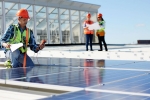CEO of DKI Jakarta Drinking Water Regional Company Priyanto Bambang Hernowo: “Jakarta’s water quality getting worse”
This article has been translated by PwC Indonesia as part of our Indonesia Infrastructure News Service. PwC Indonesia has not checked the accuracy of, and accepts no responsibility for the content.
Bisnis Indonesia: Direktur Utama Perusahaan Daerah Air Minum DKI Jakarta Priyatno Bambang Hernowo: “Kualitas Air Jakarta Kian buruk”
19 September 2018
By Fitri Sartina Dewi
Belitung — Jakarta Regional Drinking Water Company (PAM Jaya) will play a more strategic role in processing water in Jakarta, following the Supreme Court ruling to stop clean water privatisation in Jakarta. To learn more about business development plan and the readiness of PAM Jaya to carry out its duty, Bisnis interviewed PAM Jaya President Director Priyatno Bambang Hernowo. The excerpt is as follow:
What is your priority program as the President Director of PAM Jaya?
As what I have previously pointed out to DKI [Jakarta] Governor, my priority program is how to increase service coverage. Actually the service coverage figure is moving up, but because the population continues to increase, so the service coverage [figure] seems like going nowhere. To deal with that, I think an acceleration measure is needed.
One of the initiative measures is how to find water resources. To reach 80% coverage, we need an additional capacity of approximately 80,000 litres per second. Another initiative move being taken is building SPAM (Drinking Water Supply System).
How is the improvement in PAM Jaya service coverage so far?
Presently, the total amount of water distributed by PAM Jaya to every region in Jakarta reaches 20,232.5 litres per second. And, the number of customers being served hits 851,155 customers. With the capacity of 20,232.5 litres per second, PAM Jaya service coverage currently hovers at 60%.
What are the challenges in improving the service coverage?
Not too long ago, the Governor said that in these 12 years, there is no development in piped water, and the service coverage still stands at 60%. Therefore, PAM Jaya attempts to deliver what the government hopes for a basic service to their people, and support water security in Jakarta.
However, the challenge we face at the moment is there is only around 6% of water demand which is supplied from rivers in Jakarta. We still need new water resources to meet water demand in Jakarta. If with the capacity of 20,232 litres per second, the service coverage is around 60%, then if we are to increase the coverage, we need additional water of around 8,000 to 10,000 litres per second to increase service coverage to Jakarta citizens.
Why is the majority of water supply still sourced from outside Jakarta?
Most of the water resources indeed come from outside Jakarta, because the water quality in Jakarta is getting worse. Its pollution index keeps growing. That is the main challenge in processing raw water into piped water. However, we’re now trying to find a way to utilise water resources in Jakarta.
How to do so?
Next year we plan to submit a proposal to build SPAMs whose water will be sourced from Jakarta, namely Pesanggrahan SPAM and Ciliwung SPAM. From the two SPAMs, we can get additional water distribution of around 950 litres per second.
How is the progress of the SPAM construction plan?
The feasibility study has been conducted, and the groundwater withdrawal permit has been processed as well. We are sure the project can be realised soon if there is investment that can be disbursed. It will also help us raise water service coverage in the future. Once running, the two SPAMs are expected to serve around 64,000 new customers.
Besides SPAM development, is there any other development plan?
Of course there is, but if it is not supported by a fund, it won’t work. We have submitted a proposal for PMD (provincial capital investment) in the 2018 revised regional state budget to Jakarta DPRD (Regional House of Representatives) of Rp1.2 trillion to carry out several programs as part of efforts to meet water demand, such as supplying water to low-cost rental flats.
Why is supplying water to low-cost rental flats important? Because low-cost rental flats are usually built in the outskirt of Jakarta, where the groundwater quality is poor, and piped water cannot reach them. Though it may reach them, the water is small, so special attention is needed for water supply to low-cost rental flats. Aside from that, other programs that will be carried out are relocation of pipeline network affected by provincial government’s [projects], pipeline network development, and SPAM construction.
Out of the many development plans, how much increase in service coverage that PAM Jaya sets as target?
With PMD of Rp1.2 trillion, we estimate that there will be an increase in service coverage of around 5.8%, because with such a budget, we can develop pipeline network, and there will be two new SPAMs, namely Ciliwung and Pesanggrahan, which can increase water distribution supply in Jakarta.
The construction process of the two SPAMs is expected to take around 1.5 years of time, which means if the funds are ready and the construction kicks off this year, then there will be in increase in service coverage of around 5.8% in 2020.
What if the PMD proposal is not approved?
Of course we will reschedule, because the plan cannot be executed directly at once. We will see what the priority programs are to be adjusted to our budget availability. Actually the reason why we propose for a Rp1.2 trillion PMD is to accelerate the realisation of development programs and the fulfilment of water demand, but if it isn’t approved, then there should be an adjustment.
PAM Jaya has received a PMD of Rp300 billion, what programs the company has carried out?
The PMD is allocated for pipeline network installation from Hutan Kota SPAM and MBR (low-income society) service. However, at the moment, we’re still waiting for a second phase PMD proposal of Rp150 billion. The Rp450 billion cost for the network [installation] is expected to increase service coverage by more or less 2%.
What short-term programs the company will carry out?
We will focus on the operation of Hutan Kota SPAM. We always attempt to make project execution run on schedule. The SPAM is expected to produce 500 litres of water per second. With the operation of Hutan Kota SPAM, the service coverage is expected to rise by 2%, and we can potentially serve as many as 30,000 new customers.
On top of that, we also have a program of pipeline network optimisation. Currently some places have low productivity. The pipeline is ready, but there is no willingness from customers to connect [to the pipeline network]. Perhaps, they (customers) still enjoy using groundwater, but we never know whether the ground quality is good or bad.
Therefore, we need to educate customers or potential customers to utilise the pipeline connections that we have provided. With those development efforts, we are expected to bring up [service coverage] by around 3%.
What is PAM Jaya’s follow-up regarding the Supreme Court ruling to stop water privatisation in Jakarta?
As a follow-up, Jakarta Governor has set up a governance evaluation team. In a short term, the team will give recommendation to the governor regarding ongoing cooperation [with private companies]. There are several options that will later be decided or discussed, but at the moment, the team is still in discussion.
Who are the parties in the evaluation team? When will the review process be completed?
For the short-term plan, the evaluation team is given 1 month to submit the recommendation to the Governor. The team consists of professionals, NGO (non-governmental organisations], academics, the Governor’s Team for Development Acceleration (TGUPP), Jakarta Provincial Secretary, representatives from Kadin (the Indonesian Chamber of Commerce and Industry) and PAM Jaya.
Has there been any concrete move discussed by the evaluation team, considering that cooperation contract with private parties will end in 2023?
Presently there are still several things that require assessment and consideration by the evaluation team before making a decision. The team has to continuously and intensely work on the documents and hold discussions to be able to provide the best recommendation for improvement in services to Jakarta citizens to be more inclusive and with a more affordable tariff. As part of the team, we will give input, such as in terms of the readiness of PAM Jaya. In a long term, the evaluation team is also tasked to make a blueprint for clean water treatment in Jakarta.
Is PAM ready to execute the Supreme Court ruling to take over water management in Jakarta?
We will transform from the current role as supervisor to later become an operator. To get there, we will increase capacity building to ensure that whatever the decision is, we will be ready to carry it out. However, what is important for us is how we can still increase service coverage.
How is the development of a program to improve clean water connections to priority villages?
There are two scenarios that we offer to Jakarta Governor in making a policy, because there are already some villages that are served, such as Akuarium Village by using master metre [system]. Moreover, there are networks built by Housing Services Office and operated by the locals. The next pattern is a policy to serve people in Priority Villages, but at any time if the land owner exercises their right, then we can cut the connections. Those are several alternatives that we offer as a form of support to Jakarta Regional Government’s program for the development of villages and people.
Currently, we have also conducted a survey in some other villages, but we’re still discussing on the form of services because the majority [of the villages] are illegal settlements.
Do cases on pipe leakage and water theft significantly affect PAM Jaya services? What are the strategies to deal with such problems?
The percentage of water loss is still high indeed, at around 44%. Out of the figure, 20% commercial losses are caused by theft and inaccurate water metre. The remainder are because of pipe leakage and other causes. Currently, we’re continuously making improvement. Our partners have conducted a pilot project in some areas where efforts to reduce water loss are starting to show results, and then [the measures] will be implemented in other areas.

















